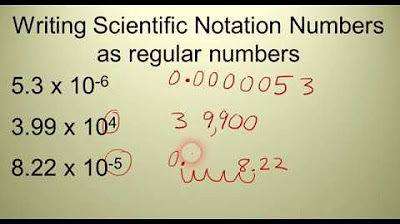High School Physics: Scientific Notation
Summary
TLDRThis educational video script introduces scientific notation as an efficient way to express both very large and very small quantities in physics. It emphasizes the importance of readability and ease of understanding, especially when dealing with vast measurements like the width of the United States or minuscule ones like the width of a transistor. The script outlines the rules for converting numbers into scientific notation, which involves placing the decimal point after the first significant figure and then multiplying by 10 raised to the appropriate power. Examples are provided to demonstrate the process, such as converting 300 million and 0.470 into scientific notation. The script encourages viewers to practice this skill with both large and small numbers and directs them to A+ Physics for further resources.
Takeaways
- 🔢 Scientific notation is used to express very large or very small numbers in a compact and readable way.
- 🌟 It simplifies writing and understanding numbers that would otherwise be cumbersome, like 4 million or 0.00000001 meters.
- 📏 The notation involves expressing a number as a single non-zero digit to the left of the decimal point, followed by the rest of the significant figures.
- ✅ Significant figures are crucial in scientific notation, and the number of these figures determines the precision of the value.
- 🔠 To convert a large number to scientific notation, place the decimal after the first non-zero digit and count the number of places moved to determine the power of 10.
- 🔄 For small numbers less than one, the decimal point is moved to the right to place a single non-zero digit to the left of the decimal, with the number of places indicating the negative power of 10.
- 📘 Examples in the script demonstrate converting numbers like 300 million, 282 micrometers, and 0.470 into scientific notation.
- 📖 To convert from scientific notation to standard form, move the decimal point the number of places indicated by the power of 10.
- 💡 Practice is recommended to get comfortable with scientific notation, especially for very large or very small numbers.
- 🔍 For additional resources and help, the script suggests visiting A+ Physics website.
Q & A
What is the purpose of using scientific notation in physics?
-Scientific notation is used in physics to quickly and efficiently express large and very small quantities in a format that is easy to read, write, and understand.
Why is it beneficial to use scientific notation for large measurements in physics?
-It simplifies the representation of very large numbers, making them easier to write and read, as opposed to writing out all the digits.
What is an example of a large measurement in physics and how is it expressed in scientific notation?
-The width of the United States, which is about 4 million meters, is expressed in scientific notation as 4 * 10^6 M.
How is the thickness of a human hair represented in scientific notation?
-The thickness of a human hair, which is about 100 microns or 0.00001 meters, is written as 1 * 10^-4 M in scientific notation.
What is the scientific notation for a transistor width on an integrated circuit that is under 0.00000001 meters?
-A transistor width under 0.00000001 meters is efficiently written as 1 * 10^-8 m in scientific notation.
What are the steps to convert a number into scientific notation?
-The steps include showing the value with the correct number of significant figures, rewriting the number with one significant figure to the left of the decimal, and then multiplying by 10 raised to the power needed to return to the original value.
How many significant figures are assumed in the example of 300 million written in scientific notation?
-In the example, it is assumed that 300 million is known to three significant figures.
What is the scientific notation for the number 0.470?
-The number 0.470 is written in scientific notation as 4.70 * 10^-4.
How do you convert the scientific notation 1.11 * 10^7 into its standard form?
-To convert 1.11 * 10^7 into standard form, start with 1.11 and move the decimal point seven places to the right, resulting in 11,000,000 or 11 million.
What is the rule for determining the power of 10 in scientific notation?
-The power of 10 is determined by the number of places the decimal point has to move to get from the original number to the form where one non-zero digit is to the left of the decimal point.
Where can one find more resources to learn about scientific notation in physics?
-For more help or resources on scientific notation, one can visit A+ Physics.com.
Outlines

Cette section est réservée aux utilisateurs payants. Améliorez votre compte pour accéder à cette section.
Améliorer maintenantMindmap

Cette section est réservée aux utilisateurs payants. Améliorez votre compte pour accéder à cette section.
Améliorer maintenantKeywords

Cette section est réservée aux utilisateurs payants. Améliorez votre compte pour accéder à cette section.
Améliorer maintenantHighlights

Cette section est réservée aux utilisateurs payants. Améliorez votre compte pour accéder à cette section.
Améliorer maintenantTranscripts

Cette section est réservée aux utilisateurs payants. Améliorez votre compte pour accéder à cette section.
Améliorer maintenantVoir Plus de Vidéos Connexes

2022 | Resumo da Aula | 1ª Série | Matemática | Aula 4 - Notação Científica - I

FISIKA DASAR KELAS X | NOTASI ILMIAH.

NOTAÇÃO CIENTÍFICA | Física, Química 8°, 9° ano , conceito e exercícios | Potencia base 10

Scientific Notation

IPA Kelas 10 - Notasi Ilmiah & Angka Penting | GIA Academy

Conversiones con Prefijos del Sistema Internacional de Unidades
5.0 / 5 (0 votes)
